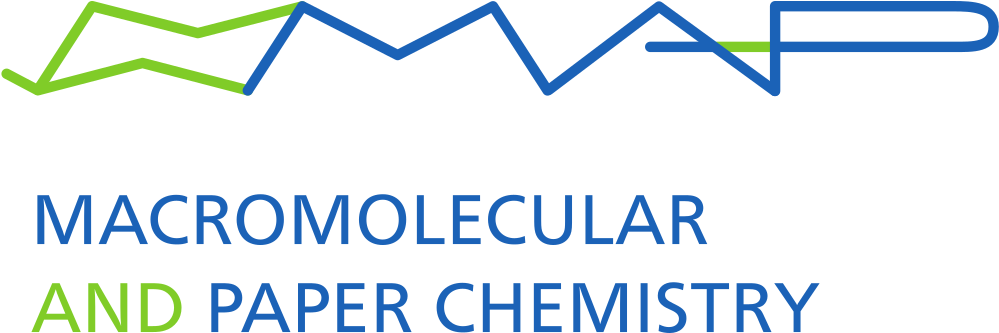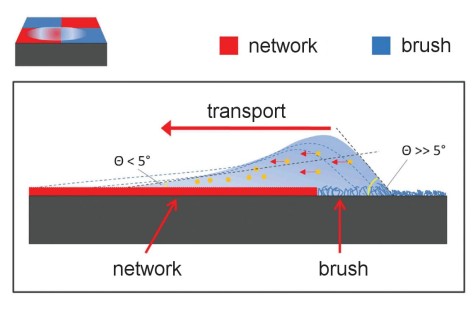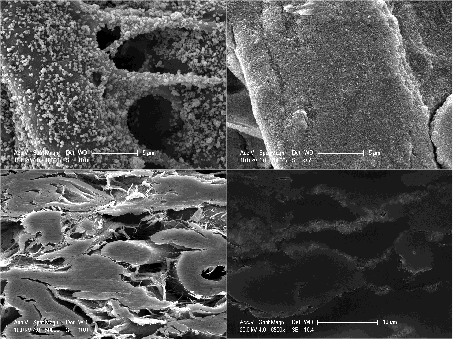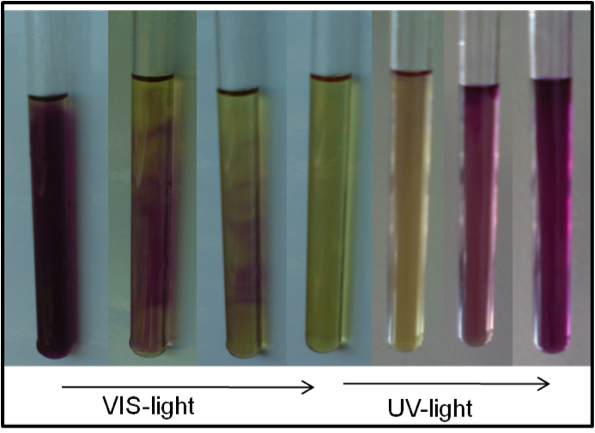Development of biomimetic Fog Harvesting Paper Surfaces
M.Sc. Carina Breuer (2022 – 2025)
The aim of this project is the development of a sustainable biomimetic surface coating on paper for the efficient collection of water from aerosol, i.e. fog. This fog harvesting surface consists of a superhydrophobic background and hydrophilic spots inspired by the namib desert beetle. The superhydrophobic background is formed by a combination of a polymer and crystallisable wax. To implement the hydrophilic spots inorganic particles are used. For further improvements it is of special interest to gain further understanding of the physical proceedings in the interaction of the system during the collection of water by collision of droplets and condensation.
Wetting and Transport on Swellable Interfaces
M.Sc. Michelle Seibert (2021 – 2024)
The aim of this project is to understand the wetting on swellable polymer brushes and networks. Especially the wetting behavior at the border between those two domains is of interest. Copolymer brushes are grafted on flat substrates using surface-initiated ATRP in a grafting from approach. By using photoreactive crosslinkers it is possible to spatially resolve the crosslinking of the surface using UV-irradiation and photomasks. This leads to very similar chemical properties but different morphologies due to the crosslinking.
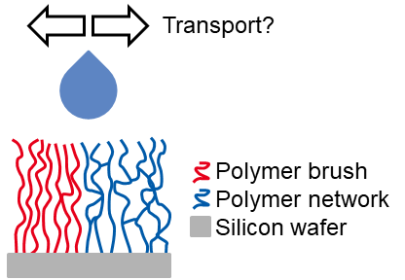
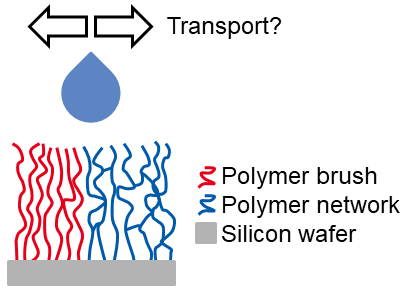
To gain a better understanding about the highly dynamic wetting process, glass capillaries are coated with polymer brushes and networks. By rotating the capillary in a centrifugal device, the gravitational force is opposing the capillary force. This way the wetting front within the capillary is stopped which leads to a quasi-steady state condition.
Stimuli-Responsive Switching of Optical Properties of Polymer Films
M.Sc. Sunna Möhle-Saul (2018 – 2023)
For the development of polymer films whose optical properties can be switched by an external stimulus, scattering phenomena, thermodynamics and kinetics of the used polymer system have to be understood. Several systems for the polymer films are explored, such as homo polymers, block copolymers, polymer blends, combined with or without additives.
In addition to the choice of material, the influence of the synthesis as well as the application method (e.g. coating method and cooling rates) are investigated.
Merck Lab – Functional Papers
M.Sc. Laura Hillscher (2017 – 2021)
Within the Merck Lab we are focused on the development of novel paper- based, low- instrumented analytical devices. This implies an extensive understanding of the interactions between paper and analytes, the fluid flow properties and ways how paper can be functionalized with antigens, enzymes etc. Newly developed paper based materials have to be tailored, functionalized and investigated. Well- established platform which are widely used in diagnostics and life science, as e.g. the home-use pregnancy test, are used for benchmarking.
The functionalization of paper to simplify sample preparation steps in medical or research analytics is one research goal of the MerckLab. For this, different immobilization strategies and their feasibility for paper, as well as different types of functionalities are investigated. By linking all the different MerckLab projects together, the overriding goal is the development of new paper-based microfluidic devices by combining the knowledge from the research areas of paper engineering, printing technology, antigen synthesis, functionalization and fluid flow properties of paper.
Wetting and transport on swellable, surface-immobilized polymer brushes and polymer networks
M.Sc. Beatrice Fickel (2016 – 2020)
To understand transport and wetting processes of complex fluids on swellable surfaces, polymer brushes and networks of several photoreactive copolymers are grafted from Si wafer and glass slides by SI-ATRP. Subsequently, their interaction with a lying drop, the topography and the swelling is characterized. Central questions are the influence of the swelling on the wetting and pinning.
As fluids, aqueous solutions of different pH values and ionic strengths as well as organic fluids are used. The connections between transport and wetting processes are to be utilized in the long term in microfluidic applications and biosensors.
Soft Control
Switching surface functionalities with stimuli-responsive polymers
Macromolecules that can be switched with respect to their conformation in a dynamic and reversible manner by using external triggers such as light, electric or magnetic fields may open a variety of novel implications for advanced applications. If such molecules are confined at interfaces, in particular, “smart polymer films" may become a key-element in the development of “intelligent & tailored surface design”, with possible applications progressing from smart catalytic systems, to smart biofunctional surfaces, and self-healing surfaces.
The Soft Control Initiative comprises 3 partners, the Technical University of Darmstadt (TUD, coordination), the Deutsches Kunstoff Institut (DKI), and the University of Applied Sciences (Hochschule Darmstadt). A total of 10 working groups from Chemistry, Biology, Biotechnology and Physics will take part right from the start of Soft Control in 2011. Besides this, strategic cooperations with the Cluster of Excellence “Smart Interfaces” (CSI), as well as with additional “associate groups” from Biochemistry and Materials Sciences are aimed to further strengthen the expertise of the Soft Control core-areas, as well as increase the visibility of this new initiative.
Cellulose-based low adhesion coating for adhesive tapes
M.Sc. Sebastian von Gradowski (until 2019)
Low adhesion paper coatings are produced in industrial scale and they are mainly composed of silicone. The silicone layer of the “release liner” protects the adhesive against dirt and enables an easy and undamaged release of the adhesive tape without loss of adhesion. Most release-liner are coated with clay to close the porous paper surface and prevent silicone penetration. The silicone is coated onto the paper surface and thermally cured by hydrosilylation reaction.
An expensive platinum catalyst is necessary for this crosslinking reaction and it is difficult to recycle the siliconized papers. A Silicone-free release coating based on modified cellulose is developed. This coating is applied to the paper surface by blade coater and it is thermally dried. This coating represents a new bio-based alternative to the common used silicone coatings for low adhesion without using an expensive catalyst.
Related publication
S. von Gradowski, M. Biesalski, 253rd ACS National Meeting and Exposion, 2017
Surface functionalization of polymer membranes with switchable polymer films for the modulation of ion transport
M.Sc. Mathias Diefenbach (until 2019)
The LOEWE Research Cluster iNAPO focuses on the chemical and biological modification of nanoporous polymer membranes produced by irradiation with heavy ions and subsequent chemical etching. The chemical modification aims will allow a control of the flux of small molecules and ions through the nanopores by a triggered swelling/deswelling of surface-immobilized polymers (figure). The latter will be addressed e.g. by external stimuli (Temperature, salt concentration or light), as depicted in the figure.
The long-term aim of the project is the integration of such membranes into lab-on-chip devices for analytical applications.
For further information follow this link: iNAPO
Polymer-modified paper substrates that reversibly respond to light
M.Sc. Wei Li (until 2017)
Light responsive polymers that change their properties when irradiated with light of the appropriate wavelength open access to promising applications, such as for example safety-papers and bank-notes, as well as low-cost UV sensors. Once they are confined on the solid substrates, surface properties (e.g. wettability, permeability and adhesion) can be dynamically changed leading to the formation of smart surfaces.
Besides, the use of paper as substrate is highly attractive owing to its unique features, such as low-cost, nontoxic, flexible, and light-weight. Based on the above information, we designed spiropyran containing polymer modified paper substrates. Such functional paper can change chromatic properties according to the switching behaviors between spiropyran (pale yellow) and merocyanine (purple) by UV and visible light (or heat).
Related publication
[1] H. Schenderlein, A. Voss, R. W. Stark, M. Biesalski, Langmuir 2013, 29, 4525.
Photo-reactive polyvinyl acetate copolymers
M.Sc. Michael Graf (until 2016)
as a functional coating can be applied onto various substrates from solution by dip-coating or doctor blading. These copolymers are synthesized using free radical copolymerization and offer uncomplicated photo-chemically induced surface-attachment and network generation properties by direct C-C bond formation via UV excitation of benzophenone moieties, which have been incorporated into the copolymer in desired ratios.
Additionally, the hydrophobic polyvinyl acetate can be converted into hydrophilic polyvinyl alcohol by simple and fast ester hydrolysis in alkaline methanolic sodium hydroxide solution. This change in surface chemistry allows direct micro structuring of a substrate surface into non-wetting and wetting domains and ultimately the fabrication of microfluidic structures or channels on a substrate by spatially resolved application of methanolic sodium hydroxide solution.
Switching polymers by applying an external electrical stimulus
Dipl.-Chem. Sander Klemme (until 2015)
Surfaces are the interface between material and environment. If it is possible to change the surface behaviour of materials we could change the reaction of materials to environmental treatment. In this work polyelectrolyte brushes will be synthesized and the swelling behaviour of this brushes will be characterized in an external electric field. The work will be based on free radical surface polymerisation of methacrylic acid copolymers. To study the switching we use surface plasmon resonance spectroscopy and ellipsometry.
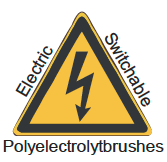
Tailor-made adhesive agents for surface modifications and specialty papers
Dr. Florian Loyal (until 2015)
Catechol-functionalized polymers show impressive adhesive properties towards various metal and organic surfaces. Among other materials the interaction between catechol groups and TiO2 surfaces point out to be one of the strongest. Due to the coordinative interactions which work both in dry and wet environment, various new applications areas arise from these properties especially for fixation and modification processes in aqueous environments. In the field of paper making TiO2 particles are mostly used due to their extraordinary optical properties as pigments in specialty papers. Additionally over the last decade an increasing interest in using its semiconductor properties for photocatalytic application like waste water treatment, or the degradation of pollutants from air is found.There has been a high interest in so called mussel-inspired polymers during the last decade. These new polymers carry catechol groups which can mimic the ultra strong adhesion properties of proteins secreted by marine mussels to different oxidic surfaces, including TiO2-surfaces even under harsh marine environments (slightly alkaline, shear forces from tides, etc.). TiO2 is a broadly used, but high cost pigment in the paper manufacture process, in order to adjust important optical properties of specialty papers (e.g. opacity). Because of its characteristic agglomeration behavior, to date a number of different additives are required to get an acceptable cost-quality output. In our research we describe a completely novel attempt to use mussel-inspired, charged and non charged, copolymers to effect different parameters of the paper making process, especially the retention, adhesion and distribution of TiO2 and other particles in the paper.
Under irradiation with light of energy higher than the band gap of the material, the photo-catalyst is able to fully mineralize organic media completely to water, CO2 and nontoxic anions, including harmful bacteria and their endo-toxines. Due to the fact that only the catalyst material and in the best way solar light is required for the mineralization, this process have huge potential as a very sustainable process for air and wastewater cleaning. Nowadays TiO2 nano particles are already used in this field, however separation of the small catalyst particles are challenging and very cost effective.
Here the combination with paper based materials as a sustainable matrix material with attractive mechanical properties lead to a much easier handling. Furthermore it opens the door for a much broader product area, due to the compatibility with standard paper product, like wallpapers etc. Nevertheless paper, mostly seen as a cheap writing material, is very complex in his structure and therefore several challenges have to overcome to set up a working catalytic composite material.
In our research we are interested in synthesizing new multi-functional polymers with adhesive and photo-reactive properties and further functional side groups for the modification of filter papers as well as other organic and inorganic surfaces. Through our tailor-made polymers we are able to homogeneously attach (photo) catalytic particles, if needed in a local resolved manner. Due to our combination of functional side groups our polymers are able to attach the particles quite strong and are stable even under rigid conditions in aqueous environments. Therefore those systems are promising for the production of photocatalytic papers used for wastewater cleaning or catalytic processes.
Light-responsive polymer films on solid surfaces
Dr. Helge Schenderlein (until 2013)
For the development of new smart surfaces, which can be switched with respect to their properties (e.g. adhesion, wetting, or absorption) in a dynamic and reversible manner, different spiropyran-based light-switchable copolymers were synthesized and were attached covalently to solid surfaces.
Upon irradiation with UV/VIS-light, these polymers undergo a reversible change within the light-sensitive group from a spiropyran (hydrophilic) to a merocyanine (hydrophobic) form in aqueous solution.For the analyzation of the polymers and the respective polymer films, as well as the switching-process different methods like ellipsometry, surface plasmon resonance spectroscopy (SPR), UV/VIS-spectroscopy, contact angle measurements are used.
Tailor-made Surfaces & Bioinspired Materials
The ability of living organisms (i.e. living cells) to respond to various environmental changes with a high specificity is as impressive as it is difficult to predict. For the integration of these advanced sensorial systems into artificial lab-on-a-chip devices (cell-chips), the spatially controlled attachment and proliferation of living cells within microscale dimensions on solid substrates is perhaps one of the key challenges.
Next to the important role of well-defined cell arrays in the automatization and acceleration of the drug discovery process, the reduction of on-chip cell colony sized down to single cell assays and the incorporation of microfluidic and sensorial systems will facilitate the investigation and perhaps enhance the understanding of cell-to-cell communication pathways.
By a simple convergent synthesis strategy, we designed bioactive, non-toxic poly(dimethylacrylamide), PDMAA polymers that carry a peptide ligand, which is recognized by receptors present in the plasma membrane of eucaryotic cells. The polymer is covalently linked to a solid substrate by simple photo-chemistry means using a surface-attached benzophenone functional site. A simple polymer synthesis combined with an efficient surface modification strategy, including lithographically structured surfaces, makes this design of bioactive interfaces very interesting for a large number of possible applications.
In a parallel work, we developed substrate-supported, polymerized peptide-amphiphile monolayers that expose a similar peptide-ligand (RGDS) in a very controlled fashion. Cells respond to these monolayers in a concentration-dependent manner, and possible applications of these supramolecular architectures may be their use as model-surfaces to study cell-material interactions.
Related Publications
[1] Tirrell, M.; Kokkoli, E.; Biesalski, M.: Surface Science 2002 (500) 61-83
[2] Biesalski, M. A.,Knaebel, A.; Tu, R.; Tirrell, M. V.: Biomaterials 2006 (27) 1259-1269.
[3] Rühe, J.; Biesalski, M.: in Comprehensive Microsystems, Vol I, p107-130, Zappe et al. (Eds.), Elsevier 2008.
[4] Petersen, S.; Loschonsky, S.; Prucker, O.; Rühe, J.; Biesalski, M.: Physica Stat. Solidi A 2009 (3) 468-473.
[5] Petersen, S. and M. Biesalski: Int J Artif Organs, 2011. 34 (2) 210-214.
[6] Petersen, S., Gattermayer, M., Biesalski M.: Bioactive Surfaces J.F. Lutz, H.G. Börner (Eds.) Elsevier 2011


